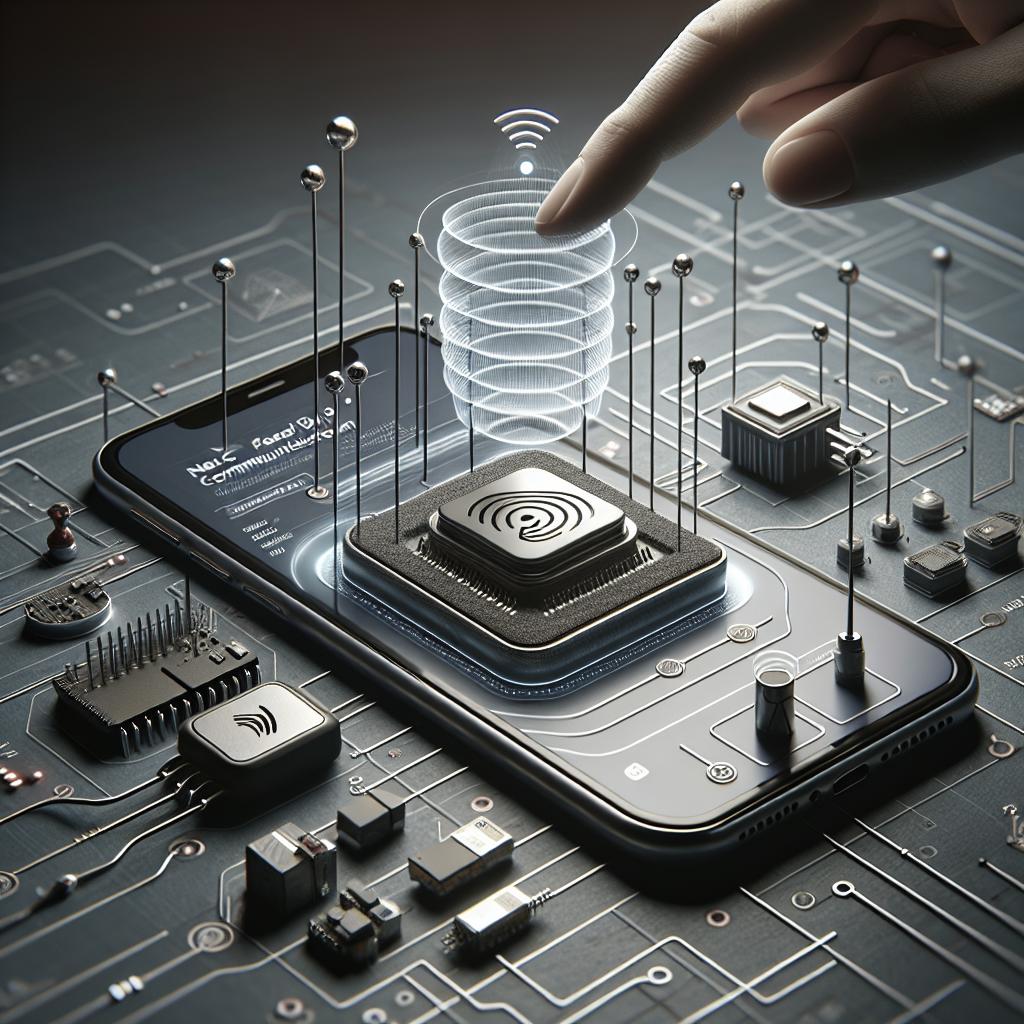Near-Field Communication (NFC) technology has transformed the way we interact with devices and the world around us. This article explores the inner workings of NFC technology, its history, benefits, and potential risks. We’ll delve into the various modes NFC operates in, like reader/write, peer-to-peer, and card emulation mode. Moreover, we highlight NFC’s applications beyond payments, spanning across healthcare, airlines, and the hospitality industry. Understanding the role of NFC in your smartphone, its safety, and whether it poses any hacking risks will be covered. Finally, we look at whether you should keep NFC enabled and offer a glimpse into its future potential, focusing on convenience, security, and much more.
What Is Near-Field Communication (NFC)?
Near-Field Communication (NFC) is a set of communication protocols that enable two electronic devices, typically a mobile device and another device like a terminal, to communicate by bringing them within close proximity, usually within 4 centimeters. Unlike other forms of wireless communication, NFC relies on electromagnetic induction between two devices to transmit data.
Developed as an extension of the concept of Radio Frequency Identification (RFID), NFC does not require a direct line of sight between communicating devices, making it distinctively practical for quick and seamless data transfer. This unique technology underpins a wide array of modern applications, from contactless payments to smart ticketing and secure access control systems.
Key Takeaways
- NFC operates over short distances, usually within 4 cm, providing convenient and secure data exchange.
- This technology is predominantly utilized for contactless payments, data sharing, and access controls.
- NFC is based on existing RFID standards, ensuring compatibility and security in communication.
Understanding Near-Field Communication (NFC)
At its core, NFC enables data exchange between two nearby devices, operating at a frequency of 13.56 MHz. It is designed to allow secure, real-time data transfer for various practical applications involving access, identity verification, payment transactions, and more.
Considered a subset of the RFID family, NFC leverages the same basic communication protocol while providing additional control and security features needed for its broader use cases. NFC interaction can occur between compatible devices in different modes, each serving specific kinds of operations and transactions.
How Does Near-Field Communication Technology Work?
NFC technology functions across different modes that facilitate versatile applications and services. Understanding these modes helps in comprehending how NFC accomplishes tasks seamlessly and efficiently.
Reader/Write Mode
This mode allows an NFC-enabled device to read data from or write data to NFC tags. Such tags are passive devices embedded in smart posters, cards, or stickers containing small amounts of information, like URLs, contact information, or settings for interactions driving consumer engagement. Reader mode is instrumental in contactless transactions and provides a touchpoint for exchanging information.
Devices, in this mode, generate an electromagnetic field used to power the NFC tag and read any stored data. This feature is particularly beneficial in marketing and engagement scenarios where businesses deploy NFC tags to provide additional context or interactive content to their audiences.
Peer-to-Peer Mode
Peer-to-peer mode facilitates direct data exchange between two active NFC devices, such as smartphones. In this mode, users can easily share various data types, including files, photos, and contacts, by simply tapping devices together, providing digital transactions without a network or spreading information about environments.
This fast and intuitive interaction model supports applications like Android Beam, allowing users to transfer online links and initiate data exchanges hassle-free. Frequent updates and enhancements ensure seamless and secure operations across diverse operating systems.
Card Emulation Mode
In card emulation mode, an NFC-enabled device can replace a smart card, allowing it to interact with existing contactless card systems, such as payment terminals and access controls. This mode is pivotal in the transition towards digital wallets where mobile devices replicate credit cards, bank cards, or transit passes.
This functionality is the backbone of mobile payment solutions, enabling users to make secure and fast transactions by placing their device near a contactless reader. Key advancements in secure element technologies, including host card emulation, guarantee the protection of sensitive payment information.
History of NFC
NFC technology has a rich history dating back to its roots in RFID systems of the 1980s. The need for more interactive wireless tools gave rise to NFC developments spearheaded by major tech giants and industry consortiums. By the early 2000s, experiments with NFC applications in public transportation and secure access systems accelerated mass adoption.
The official introduction of NFC standards by ISO/IEC in the early 2010s was a game-changer, defining the protocols for interoperability and security. The technology’s integration into mainstream consumer devices—starting with the adoption by mobile giants and payment networks—has since evolved markedly, fostering innovation across numerous industry sectors.
Benefits of NFC
NFC technology offers several benefits that stem from its versatile nature and ability to promptly share information between compatible devices. This makes it a widely adopted technology across industries and personal use.
Convenience
The primary advantage of NFC technology lies in its convenience. Users can quickly and effortlessly complete transactions or exchange data by simply placing devices close to each other. This ease of use is a significant driver behind its popularity in mobile payment solutions, consumer interactions, and public transport systems.
Furthermore, NFC’s compatibility with other communication standards means no additional hardware is needed for most modern smartphones, making its integration seamless in everyday activities.
Security
NFC provides an extra layer of security by virtue of its close proximity requirement, reducing the risk of interception by unauthorized devices. Enhanced encryption and secure channels further ensure data protection during transmissions.
This inherent security makes NFC a preferred option for payments and personal identification management, as it adheres to stringent compliance and data protection standards necessary for safeguarding sensitive information.
Sharing
Sharing data via NFC is a straightforward and user-friendly process. Whether it’s exchanging business cards, photos, or documents, NFC sustains fast and reliable transfers that benefit both personal and professional landscapes.
Innovative applications have leveraged this capability to provide seamless user experiences, enabling transactions, conference networking, and building smart interactive environments.
Targeted & Context-Specific Advertising
For marketers and businesses, NFC opens a new horizon of targeted advertising opportunities. NFC tags embedded in products or promotional materials can convey personalized marketing content directly to consumers’ devices based on location and engagement context.
This increases the effectiveness of marketing campaigns by delivering context-specific messages, driving customer involvement, and facilitating direct actions like purchasing or inquiry on-the-go.
NFC Drawbacks and Security Risks
While NFC technology holds various practical applications, it’s not without limitations and potential security challenges. These need to be addressed to enhance user trust and expand its usage scope.
Power Constraints
One of the primary limitations of NFC-enabled devices is their dependence on battery power, especially concerning active devices like smartphones. In situations where battery life is critical, prolonging operational efficiency can become a decisive factor.
This requirement for constant power can at times limit the use of NFC for extended periods, especially for energy-hungry devices that must also support other functionalities simultaneously.
Security Concerns
Despite its secure communication layer, NFC is susceptible to certain threats, such as data interception during exchange and unauthorized access through rogue devices. As with any wireless technology, potential security vulnerabilities must be vigilantly managed.
Stakeholders need to ensure robust security protocols, regular updates, and user education to mitigate these concerns and better protect sensitive data from exploitation or loss.
Digital Pickpocketing
Digital pickpocketing—or ‘e-pickpocketing’—is a modern threat where criminals can potentially access NFC-enabled devices discreetly to steal data or funds. Although the proximity requirement reduces this likelihood, it remains a concern in crowded public places.
To counteract such threats, users can adopt practical strategies, including disabling NFC when not in use, setting strict permissions, and using protective wallet cases to shield their devices.
NFC: Beyond the Payment Process
The influence of NFC extends far beyond financial transactions. As technology evolves, its applications, particularly in emerging sectors, reveal a future filled with potential and broader connectivity.
Innovative implementations of NFC include applications in smart homes for automation, smart packaging that informs consumers, and interactive kiosks that provide dynamic updates. Each of these builds upon NFC’s capabilities to deliver more than just monetary facilitation.
NFCs Offer Near- and Long-Term Solutions
Several industries have begun adopting NFC technology beyond the scope of traditional transactions, showcasing its adaptability and foresight in problem-solving.
Healthcare
In healthcare, NFC has proven invaluable for tracking patient data, managing inventory, and ensuring secure access to medical devices and sensitive information. NFC can empower patient monitoring, providing doctors with real-time data for quick diagnoses and care management.
Additionally, NFC ensures efficient management of resources—limiting unauthorized access to high-value equipment, medicines, and system controls—streamlining operational efficiency while safeguarding patient data integrity.
Airlines
NFC technology in airlines has optimized everything from check-ins to boarding processes by allowing passengers to use their devices as boarding passes. The ease of updating information ensures passengers receive seamless service and accurate details.
This integration assists in reducing congestion at airports, ensuring secure identification checks and enabling nuanced tracking of luggage, ultimately improving passengers’ overall travel experience.
Hospitality, Travel, and Leisure
Beyond convenience, NFC has transformed the hospitality and entertainment sectors, offering guests customizable experiences. From unlocking hotel room doors with NFC-enabled devices to managing amenities like pool access, NFC empowers consumers in navigating seamless experiences.
In theme parks, for instance, NFC wristbands simplify payment processes, personalizing attractions and synchronizing with social media platforms, enabling guests to share real-time experiences.
What Does NFC Do on My Phone?
Smartphones equipped with NFC expand their utility and function-list exponentially. Users can rely on NFC to facilitate contactless payments, exchange personal information wirelessly, and access services like public transport or workspace doors.
NFC on smartphones unlocks an ecosystem of applications, allowing developers to offer new features within social networking, e-commerce, and utility services without additional cost or accessory licensing requirements.
Should NFC Be on or Off?
Leaving NFC activated has both positives and considerations, depending on user experience and security prerequisites. For optimal security in less-frequent usage situations, disabling NFC could mitigate unauthorized access risks.
However, for users who frequently make payments or interact with NFC-compatible devices, keeping it on ensures readiness and convenience. Users must weigh their usage habits against potential security implications, adopting suitable measures to enhance safety.
Is NFC Dangerous?
NFC is predominantly safe owing to its proximity limits, making unauthorized access challenging without direct physical presence. Standards and security protocols ensure data trade-offs maintain precision and privacy.
Ongoing security evaluations amidst technological advancements preserve faith in NFC applications and create balanced protection priorities, assuring users of its continued safety within specified norms and applications.
Can You Be Hacked Through NFC?
Though NFC is regarded secure, any wireless technology can face potential vulnerabilities. Digital adversaries could exploit NFC’s connectivity for illicit access under specific circumstances.
With informed vigilance, installing security patches, and understanding risks, individuals and enterprises can preclude potential breaches—ensuring NFC retains its respected status as a safe, user-friendly communication tool.
The Bottom Line.
| Topic | Summary |
|---|---|
| Understanding NFC | NFC is a short-range communication technology enabling device interactions for payments, data sharing, and secure access. |
| History and Development | NFC has evolved from RFID systems, leading to diverse applications and standards ensuring compatibility and security. |
| Benefits | Convenience, security, data sharing, and context-specific advertising make NFC a valuable tool across industries. |
| Drawbacks and Risks | Power constraints and security threats such as digital pickpocketing pose challenges needing management and user awareness. |
| Industry Applications | NFC’s role extends beyond payments into healthcare, airlines, and hospitality, offering efficient solutions and personalized experiences. |
| Practical Considerations | Understand NFC’s safety, its implications for everyday users, and strike a balance between usability and protection. |


